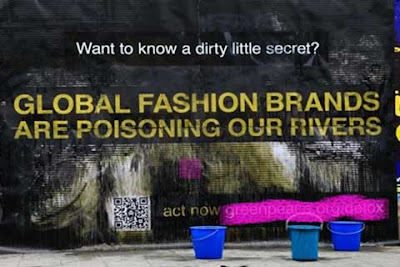Today is the forth anniversary of the tragedy at Rana Plaza. On this day in 2013, one thousand one hundred thirty-three (Laverne, Michael, Fitting Fashion: Rethinking the Way We Make, Market and Buy Our Clothes) people died when the factory building where they were working collapsed in Dhaka, Bangladesh. International attention focused on the cheap fast-fashion clothing produced by many of those who died. As international attention grew, it gave birth to the Fashion Revolution movement which asked questions and raises issues of worker's rights and the fractured fashion supply chain. Fashion Revolution would like us to ask and investigate one question today, "Who made my clothes?"
In a 2013 article, Ryerson School of Fashion professor, Osmud Rahman acknowledged "the average person doesn't have enough information at hand about where and how their clothing is made." It's not just the clothing, the same can be asked of the raw materials that are used to make our clothing. The stories behind ready-to-wear clothing are not just the stories of the garment workers sitting at a sewing machine but also the farmers growing textile crops, the scientists working on new textiles and the people decorating our fabrics with dyes and chemicals.
I can say that I make my own clothes but I honestly can not tell you much about a majority of the supplies I use to make my clothes. Fabric stores are selling fabrics that are labelled and marketed as organic but not much more. There is little transparency in labels to back that up or list the material's organic percentage. And it is rare that I stumble on a fabric's country of origin unless I'm buying high quality wools from Italy or England.
There is so much to learn about our supply chain and the materials that end up in our sewing tables. I have to admit, I've made mistakes through my own ignorance when purchasing lesser quality fabrics. But I hope to continue to learn and educate myself and cherish the work of those who share their craft rather than fall pry to marketing of fashion fashion trends.
So who made your clothes? As if I have to ask on a sewing blog. And what tough questions do you ask on this day?
Happy Sewing!
 |
| Necklace made from up cycled clothing labels and wool, cotton knit top (Vogue 9056), and black wool pants (OOP Vogue 1325) |
In a 2013 article, Ryerson School of Fashion professor, Osmud Rahman acknowledged "the average person doesn't have enough information at hand about where and how their clothing is made." It's not just the clothing, the same can be asked of the raw materials that are used to make our clothing. The stories behind ready-to-wear clothing are not just the stories of the garment workers sitting at a sewing machine but also the farmers growing textile crops, the scientists working on new textiles and the people decorating our fabrics with dyes and chemicals.
So who made your clothes? As if I have to ask on a sewing blog. And what tough questions do you ask on this day?
Happy Sewing!

.png)

.jpg)



Super cute picture! Important to find out where the fabrics come from, hopefully that will continue to be the next wave.
ReplyDeleteThanks. It's not often that I like to jump in front of the camera, I tend to rely on my mannequin to show-and-tell my makes, but this was an important event. Back to hiding behind the camera.
DeleteThank-you for remembering this anniversary. And thank-you for pointing out that we who sew really have no idea where our fabrics come from. We're a bit smug about making our clothes, but we rarely stop to think that those bargain fabrics that we love to find are so often a detriment not only to the environment, but also to the people who produce them.
ReplyDelete